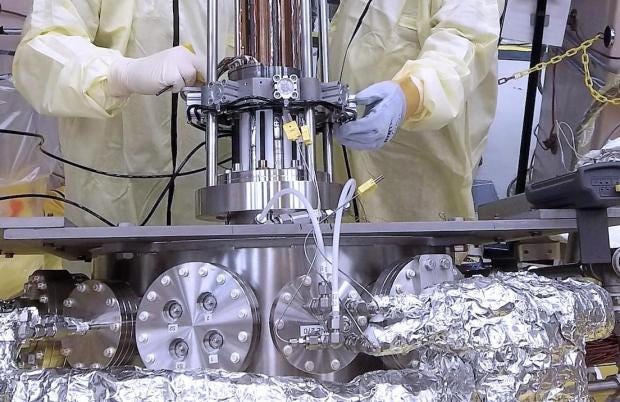NASA says it has completed
testing on a new nuclear fission power system for deep space missions – and the
results went extremely well. The system is called Kilopower, and it involves
using the heat generated by uranium to produce power. It’s a $20 million
project that’s been billed as a way to support human missions to the Moon,
Mars, and beyond.
At a conference at the NASA
Glenn Research Center in Ohio, engineers from the $20 million project revealed
results of the tests, conducted earlier this year in the Nevada desert. And
they said their prototype, called KRUSTY (Kilopower Reactor Using Stirling
Technology), exceeded all of their expectations.
“I’m really glad to be able
to report back to you that the test went great,” Marc Gibson, the lead engineer
on Kilopower, said at the event.
A rod of boron carbide
starts the fission reaction in the uranium, producing heat that’s transported
by pipes to the power generators, known as Stirling converters. On top of the
reactor is a large circular radiator, which emits the excess heat from the
reactor. In total, a finished reactor would measure about 2 meters (6.5 feet)
tall.
To prove it worked,
engineers built a smaller KRUSTY prototype and ran it at temperatures of
hundreds of degrees, putting it through its paces to see just how useful it
could really be. On March 21 they concluded their testing, which included a
demonstration that lasted for 28 hours. And things went pretty well.
It produced up to 1 kilowatt
of power, but the team noted this was easily scalable up to 10 kilowatts with
their existing system. Future designs for the Moon and Mars could reach 40
kilowatts.
“Kilopower is ingenious in
its design,” James Reuter, acting associate administrator of NASA’s Space
Technology Mission Directorate, said at the conference. “The aim is to solve
key technological challenges that will enable more ambitious human science
missions in the future.”
This was the first time a
new nuclear reactor of any sort had been tested in the US for 40 years, let
alone one designed for space. So the fact the test was a success will be pretty
welcome news for people dreaming of ideas for future missions. Kilopower, in theory, opens
up a lot of doors.
Some deep space missions
already use a source of nuclear fuel, radioisotope thermonuclear generators
(RTGs), which rely on the decay of plutonium-238. But they are limited to a
maximum power of about 1 kilowatt.
“We start where the RTG
stops,” Gibson noted in the conference. “One kilowatt is our lowest level, and
you can go up to megawatts of power.” Another benefit of Kilopower over RTGs is
that the latter constantly run, and cannot be turned off once the process
begins. The former, however, could be started at any time during a mission, and
its power output is completely scalable too.
It was noted that as the
reactor isn’t turned on until it reaches space, Kilopower also has an added
layer of safety prior to launch, allaying some nuclear-related concerns.
“If there was a 15-year
mission to the Kuiper Belt, we don’t have to start the reactor up until we get
there,” added Gibson.
With the completion of this
test, the team said they no longer had any need for further ground
demonstrations. Now they’re seeking approval to actually test the Kilopower
system in space, something that will be looked at over the next 18 months.
With NASA continually
looking to broaden its horizons, be it the Moon or Mars, a source of power like
this is pretty desirable. It’s fairly cheap, easy, and provides more juice than
other sources like solar power. If we want to conduct prolonged stays on other
worlds, we may well need something like Kilopower to make that a reality. So
what do you think about this?






